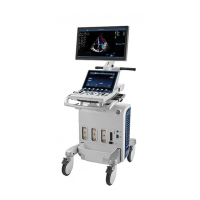Safety
2-8 Vivid S70 / S60 – User Manual
BC092760-1EN
01
System controls affecting acoustic output
The operator controls that directly affect the acoustic output are
discussed in the Acoustic Output Data Tables in the Reference
Manual. These tables show the highest possible acoustic
intensity for a given mode, obtainable only when the maximum
combination of control settings is selected. Most settings result
in a much lower output. It is important to note the following:
• The duration of an ultrasound examination is as important
as the acoustic output, since patient exposure to output is
directly related to the exposure time.
• Better image quality yields faster clinical results, making it
possible to complete the relevant ultrasound examination
more rapidly. Therefore, any control that improves the
quality of the examination can help to reduce patient
exposure, even though it may not directly affect acoustic
output.
Probe selection
As long as the appropriate application is available, any probe
can be used with the knowledge that the intensities fall at, or
below, those stated in the Acoustic Output Data Tables. The
duration of patient exposure is most likely minimized with the
use of a probe that is optimized to provide resolution and focal
depth, appropriate to the examination.
Application selection
Selecting the probe and application preset appropriate to a
particular ultrasound examination automatically provides
acoustic output limits within FDA guidelines for that application.
Other parameters which optimize performance for the selected
application are also set automatically, and should assist in
reducing the patient exposure time. See ‘Connect and
disconnect probes’ on page 3-26, for information on selecting
probes and application presets.

